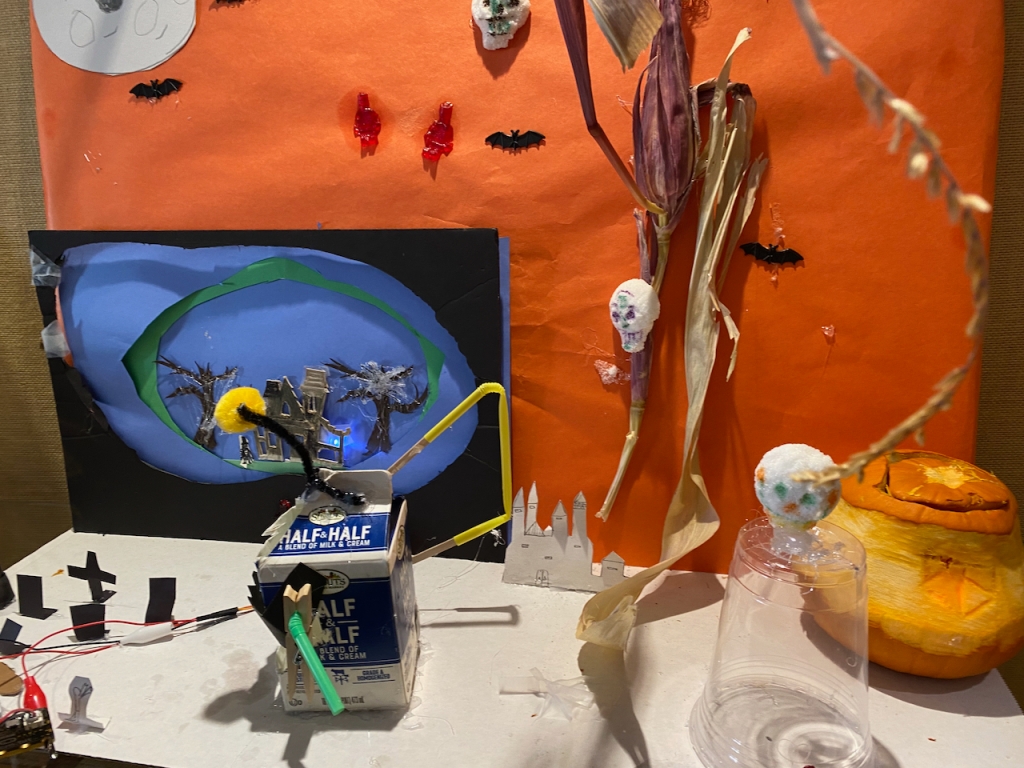Halloween Displays: A Perfect STREAM (Science, Technology, wRiting, Engineering, Art, Math) Lesson
Wow, wow, wow! My students finished their displays in time for Halloween after spending many, many hours working on them. Now, they are in display cases in the lobby of our elementary school. I am so proud of them and rightfully, they are very proud of themselves, too. They worked so hard on them.
A little history . . . I love Food Channel’s competitions and Halloween Wars tops my list. This is where I got the idea for this lesson. Each Halloween season, I become enamored with the passion, creativity, talent, and skill of the sugar, cake, and pumpkin artists on this show. This led me into wanting to bring this type of passion into my classrooms; so several years ago I started a yearly Halloween Wars during each Halloween season (none during our COVID shutdown, though); and yes, it’s a team competition which makes it even more exciting for the students. Needless to say, I was thrilled to bring it back this year allowing a new group of students the opportunity to experience it. As mentioned in the title, I believe this to be a perfect STREAM (Science, Technology, wRiting, Engineering, Art, Math) lesson. This post describes the learning activities and standards addressed.
Background Information
The principles that drive my instructional approach. regardless of theme, include:
- Instructional challenges are hands-on and naturally engaging for learners.
- There is a game-like atmosphere. There are elements of play, leveling up, and a sense of mastery or achievement during the instructional activities.
- The challenges are designed to be novel and create excitement and joy for learners.
- There is a healthy competition where the kids have to compete against one another.
- Learners don’t need to be graded about their performances as built-in consequences are natural.
- There is a natural building of social emotional skills – tolerance for frustration, expression of needs, working as a team.
- Lessons are interdisciplinary (like life) where multiple, cross-curricular content areas are integrated into the instructional activities.
These have been further discussed in A Model of Good Teaching?
The goals included the following:
- To work in a small group to create a Halloween scene using art work, LEDs, microcontrollers, servos, food items, and miscellaneous materials.
- To work as a small group to craft a story about their scene.
- To introduce and reinforce ideas, concepts, and skills associated with maker education, STEM, STEAM, and STREAM.
- To engage in a friendly team competition whereby collaboration in their small groups would lead to success in the competition.
Descriptions of the Individual Components
Science Related Activities and Standards
Learners did several activities that involved LED circuits (simple LED lights, LED Tea Light Spider Pumpkins, and Paper Circuit Skulls) and circuits with microcontrollers (see Technology section).
Science Standard:
- NGSS: 4-PS3-2. Make observations to provide evidence that energy can be transferred from place to place by sound, light, heat, and electric currents.
Technology Related Activities and Standards
For their displays, learners used servo socks to make parts of their display turn, micro:bits and servos to make milk carton robots, and Circuit Playground to make a flickering light to put inside their carved pumpkins. They needed to code their micro;bits and Circuit Playgrounds.
Computer Science Standards:
- 1B-CS-02 – Model how computer hardware and software work together as a system to accomplish tasks.
- 1B-AP-10 – Create programs that include sequences, events, loops, and conditionals
- 1B-CS-03 – Determine potential solutions to solve simple hardware and software problems using common troubleshooting strategies

wRiting – Language Arts Related Activities and Standards
Learners wrote stories that drove their displays. They did so in Google docs so they could write collaboratively. My “rule” was that they could only use elements in their displays that were part of their stories. This necessitated that they revisit their stories throughout this lesson.
ELA Standard:
- CCSS.ELA-LITERACY.W.5.3: Write narratives to develop real or imagined experiences or events using effective technique, descriptive details, and clear event sequences.
Example Stories:
Engineering Related Activities and Standards
Overall, engineering was used throughout this project from creating display artifacts – one student built a cardboard refrigerator with working parts and the milk carton robot to figuring out how to hang and arrange things on their display board.
NGSS Engineering Standards:
- 3-5-ETS1-1. Define a simple design problem reflecting a need or a want that includes specified criteria for success and
- constraints on materials, time, or cost.
- 3-5-ETS1-2. Generate and compare multiple possible solutions to a problem based on how well each is likely to meet the
- criteria and constraints of the problem.

Arts Related Activities and Standards
The entire display was an arts related activity, but I include a specific art activity, the Spooky Halloween 3D Art Project.
National Core Arts Standards:
- Anchor Standard #1. Generate and conceptualize artistic ideas and work.
- Anchor Standard #2. Organize and develop artistic ideas and work.
- Anchor Standard #3. Refine and complete artistic work.
Math Related Activities and Standards
Learners made their own Sugar Skulls and Gummy Legos (Bears) using recipes I projected on the Smartboard. They were asked to cut the recipes in half or thirds.
Math Standard:
- CCSS.MATH.CONTENT.5.NF.B.7: Apply and extend previous understandings of division to divide unit fractions by whole numbers and whole numbers by unit fractions.
It was so much fun to find and design these activities but it was even more fun watching the learners do them all. I can’t wait until next year!









Leave a comment